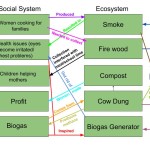The core ideas behind my system diagram were to show the benefits of the biogas generator and the interactions between the social system and the ecosystem. The concept of landscape comes to mind when thinking about social system and the ecosystem of the Indian village. The main issue shown on my diagram was that women cooking had negative effects on the environment (i.e. wood collection caused deforestation) and even negative effects within their own system (i.e. health issues). The concept of biogas and the biogas generator solved those issues by using cow dung as its power source. This eliminated the demand to cut down trees for wood (deforestation) and the need for children to collect the wood. Also, my diagram shows how the women make a profit selling the compost from leftover cow dung. As long as the villagers cook with biogas, this village will most likely leave its resilience state and move onto being stable.
In comparison to Marten’s figure, mine is set up is similar. For example, we both show biogas in the social system and biogas generators in the ecosystem. However, it seems like he focuses on larger concepts (i.e. human population), while I focused on smaller concepts (i.e. women and children). I believe that the reason why there are similarities and differences between my diagram and Marten’s is simply because of perspective. In other words, Marten and I interpreted some aspects similarly, while other aspects he and I interpreted differently. What I think can be learned by comparing the two diagrams is that it is important to have multiple perspectives. The reason why is because by looking at Marten’s diagram, I was able to consider things that I probably would not have thought about prior to the comparison. As a result, I now have a better understanding of the linkages between the social and ecosystems shown in the movie.

